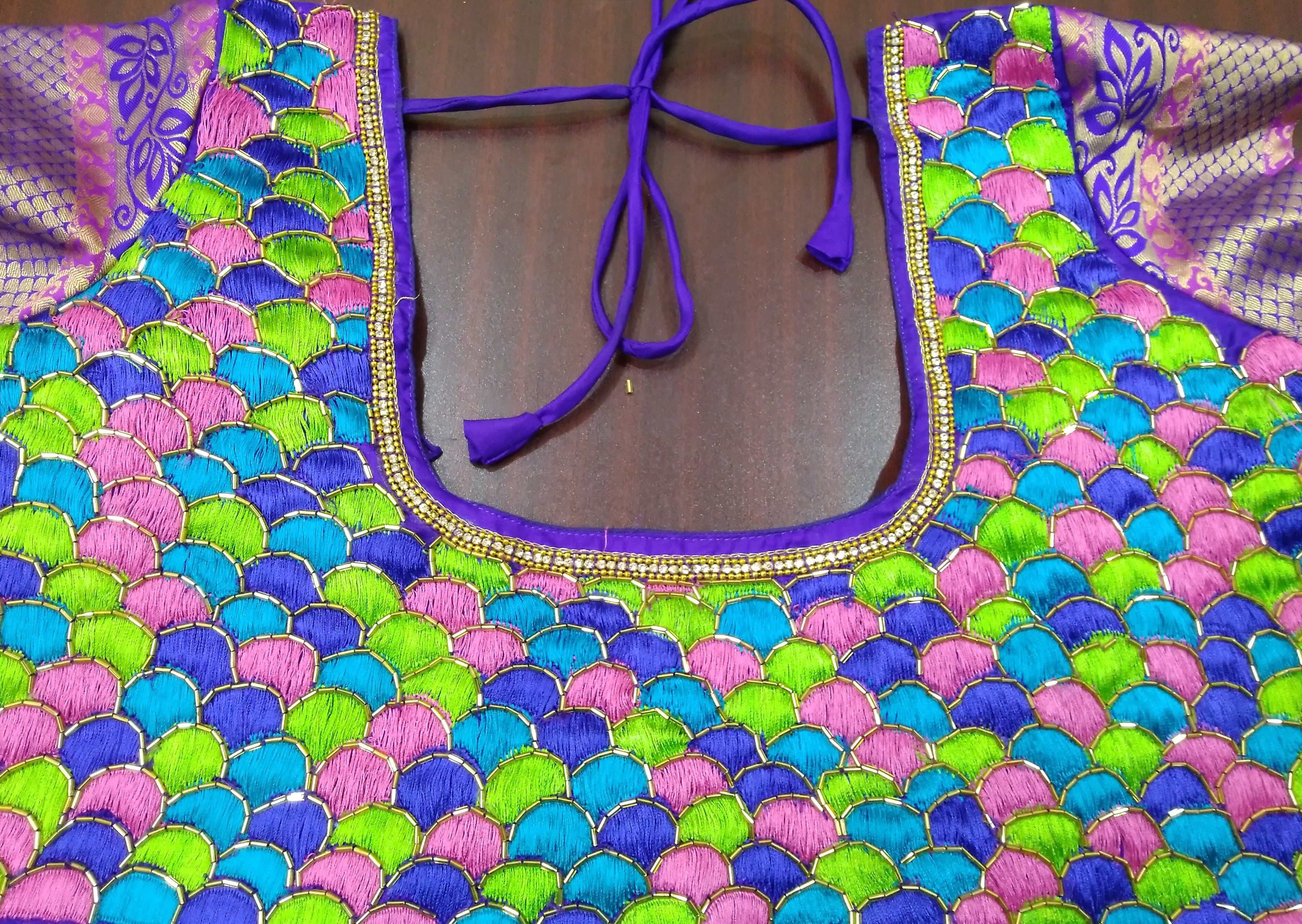Hand embroidery training in Chennai. Our student did this neck model in hand embroidery, her work is neat and beautiful.
Hand embroidery is a traditional art form that has been passed down through generations. It is a skill that involves using needles and thread to create intricate designs on fabric. Hand embroidery is a versatile technique that can be used to embellish a variety of garments, from sarees and kurtas to blouses and dresses. If you are interested in learning hand embroidery, then Chennay Fashion Institute is the best place to start.
The Benefits of Learning Hand Embroidery at Chennay Fashion Institute
Chennay Fashion Institute is one of the best institutes in India that offers comprehensive courses in fashion design and embroidery. Here are some of the benefits of learning hand embroidery at Chennai Fashion Institute:
- Expert faculty with years of experience in hand embroidery
- State-of-the-art facilities and equipment
- Hands-on training in all aspects of hand embroidery, from basic stitches to advanced techniques
- Personalized attention and guidance from faculty members
- Opportunities to showcase your work at fashion shows and exhibitions

The Art of Hand Embroidery
Hand embroidery is a traditional art form that has been practised for centuries. It involves using a needle and thread to create intricate designs on fabric. Hand embroidery is a versatile technique that can be used to embellish a variety of garments, from sarees and kurtas to blouses and dresses. Here are some of the basic stitches that you will learn when you take a hand embroidery course at Chennai Fashion Institute:
Straight Stitch
The straight stitch is the most basic stitch in hand embroidery. It is a simple stitch that is used to create straight lines or outlines. To create a straight stitch, bring the needle up through the fabric at the starting point, and then take it down through the fabric at the ending point. Repeat this process to create a line of stitches.
Back Stitch
The back stitch is a versatile stitch that is used to create outlines, text, and decorative designs. To create a back stitch, bring the needle up through the fabric at the starting point, and then take it down through the fabric a short distance away. Bring the needle up through the fabric at the starting point again, and then take it down through the fabric at the next stitch point. Repeat this process to create a line of stitches.
Satin Stitch
The satin stitch is a decorative stitch that is used to fill in shapes and designs. To create a satin stitch, bring the needle up through the fabric at the starting point, and then take it down through the fabric a short distance away. Bring the needle up through the fabric at the starting point again, and then take it down through the fabric at the next stitch point. Repeat this process to fill in the shape or design.
French Knot
The French knot is a decorative stitch that is used to create raised dots or small clusters of knots. To create a French knot, bring the needle up through the fabric at the starting point, and then wrap the thread around the needle twice. Hold the thread taut with your other hand, and then insert the needle back into the fabric close to the starting point. Gently pull the needle through the fabric to create a knot.
The Benefits of Learning Hand Embroidery
Learning hand embroidery is a valuable skill that can benefit you in many aspects.
Chennay Fashion Institute believes in the philosophy of ‘Learning by doing’, and thus provides ample opportunities for students to showcase their creativity and skills through various projects and competitions. The institute has a team of experienced faculty members who impart knowledge and skills in a structured manner, making sure that every student gets individual attention and guidance. Apart from regular classes, students also get hands-on experience through workshops, internships, and industry visits.

Hand Embroidery Course Details
The hand embroidery course at Chennay Fashion Institute is designed to teach students the basics of embroidery and then gradually progress to advanced techniques. The course duration is 6 months, and students are required to attend classes for 4 hours every day. The curriculum is a mix of theory and practical sessions, with an emphasis on practical training. The course covers the following topics:
- Introduction to Embroidery
- Types of Embroidery
- Stitches and Techniques
- Fabric Selection and Preparation
- Design Creation and Transfer
- Embroidery on different types of fabric
- Finishing and Embellishment
Course Highlights
The hand embroidery course at Chennay Fashion Institute has several highlights that make it unique and different from other institutes. Some of the highlights are:
- Experienced Faculty: The hand embroidery course is taught by experienced faculty members who have years of experience in the industry. They are passionate about embroidery and are committed to imparting their knowledge and skills to the students.
- Practical Training: The course is designed to provide hands-on training to the students. They are encouraged to work on different types of fabrics and experiment with different stitches and techniques.
- Customised Curriculum: The curriculum is customised to suit the needs and requirements of the students. They are given individual attention and guidance, and the curriculum is adjusted based on their progress.
- Industry Visits: Students are taken for industry visits to see how embroidery is done in the real world. This helps them to understand the industry better and also provides them with networking opportunities.
Course Structure
The hand embroidery course at Chennay Fashion Institute is divided into three levels:
- Beginner Level: In this level, students are taught the basics of embroidery. They are taught how to create designs, transfer them onto fabric, and stitch basic embroidery stitches.
- Intermediate Level: In this level, students learn advanced embroidery stitches and techniques. They are taught how to embroider on different types of fabrics and also how to mix and match different stitches.
- Advanced Level: In this level, students learn how to create intricate designs and patterns. They are taught how to embellish their embroidery with beads, sequins, and other materials.
Course Benefits
The hand embroidery course at Chennay Fashion Institute has several benefits. Some of them are:
- Career Opportunities: After completing the course, students can pursue a career in embroidery. They can work as embroidery designers, embroidery artists, or even start their own embroidery businesses.
- Creative Outlet: Embroidery is a creative art that allows individuals to express themselves through their work. The course provides students with a platform to explore their creativity and create unique designs.
- Personal Development: Embroidery requires patience, focus, and attention to detail. The course helps students to develop these skills, which can be applied to other areas of their lives as well.

Conclusion
Hand embroidery is an ancient art that has stood the test of time. It is a beautiful and intricate art that requires skill, patience, and creativity. The hand embroidery course at Chennay Fashion Institute is designed to teach students the art of embroidery in a structured and comprehensive manner. With experienced faculty members, practical training, and a customised curriculum, students can be assured of a high-quality education
